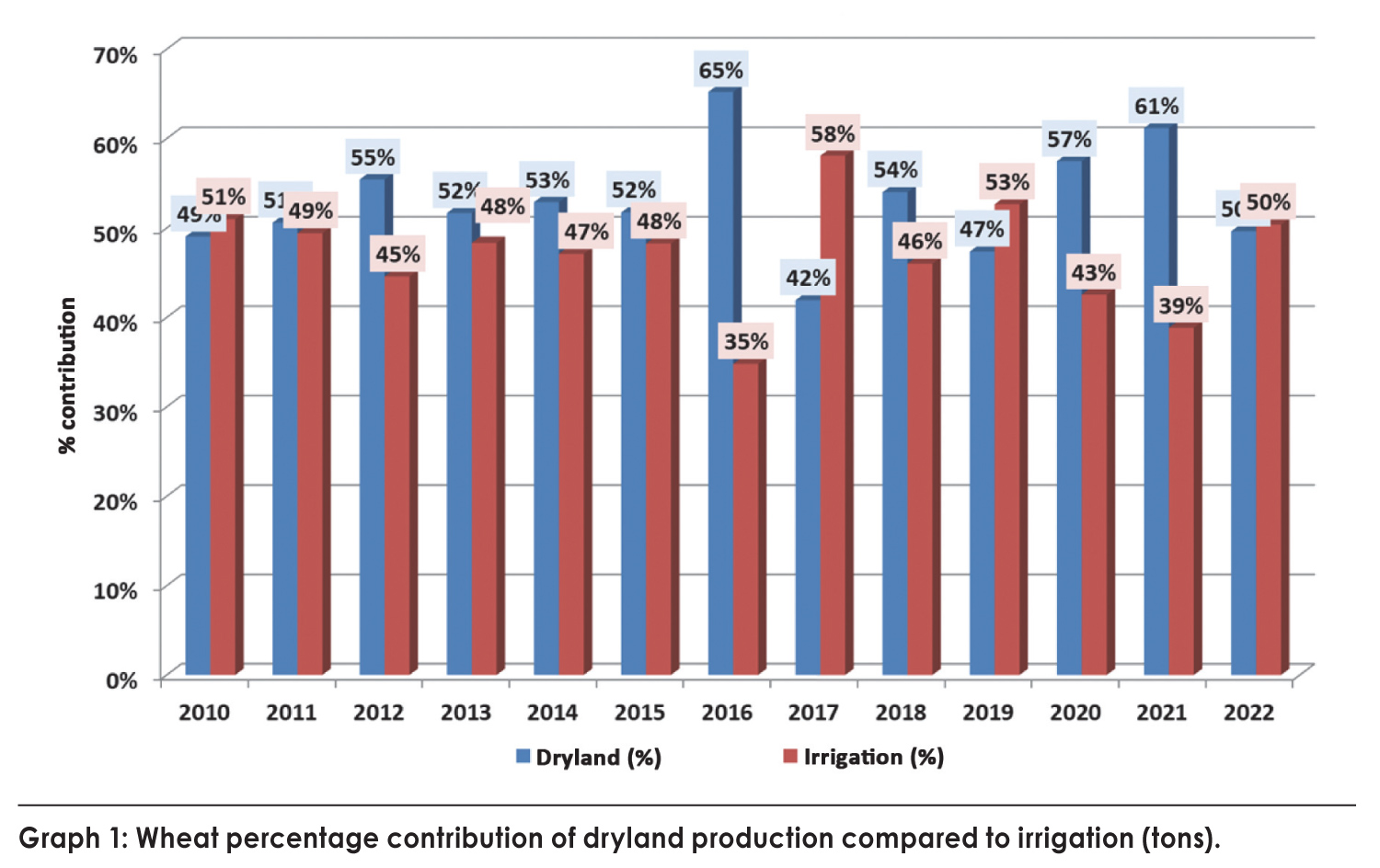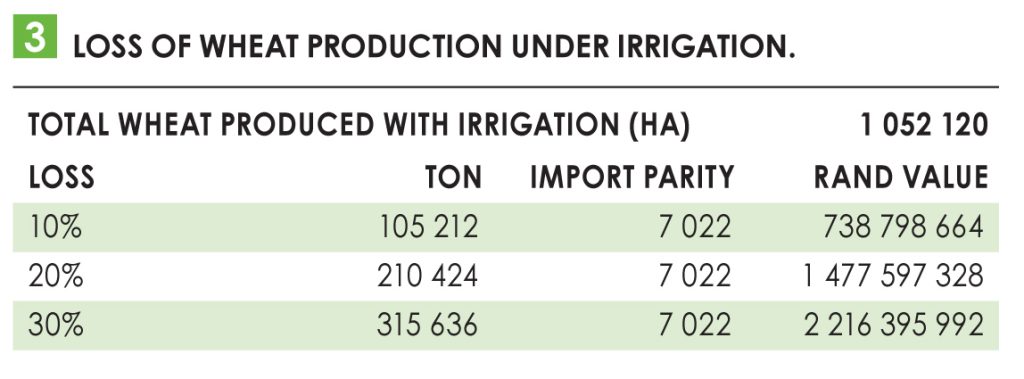
agricultural-economist,
Grain SA,
christiaan@grainsa.co.za
On average South Africa annually produced 1,82 million tons of wheat in the last ten years. Of the total hectares, 75% is planted on dryland with only 25% under irrigation. If we look at production as a whole, we do see that only 53% of total production is produced by dryland areas and 47% under irrigation. Irrigation as a whole therefore makes up a large part of the country’s wheat production. The Western Cape is the province where most wheat is grown, with 64% of the total wheat area and 44% of the total tons.
Normal irrigation costs for the producer in Limpopo and in the Northern Cape are respectively R5 775/ton and R6 126/ton under normal conditions. Normal conditions refer to the ability that producers used to have to schedule irrigation better due to the uninterrupted availability of electricity. This enabled them to irrigate at night when effectiveness is higher and not to irrigate during peak times, because electricity is more expensive during these periods. Producers could also adjust irrigation in line with the crop’s growth phase when the need for water changed. With the current power situation, this is no longer possible and producers are forced to irrigate when electricity is available. This situation also causes irrigation systems to be active for shorter periods and to be switched on more often, further driving up labour costs. In most cases, these short periods are not enough to meet the crop’s irrigation needs and alternatives must be found to supply power to systems. Generators are currently the most practical and effective way. This form of electricity generation can increase the producer’s irrigation costs by up to 20%.

 The sensitivity analysis shows the change in profit with the change in yield due to the lack of irrigation, and the change that can occur if a producer decides on a generator, which can increase his irrigation costs. The table clearly indicates that if yield is not affected and irrigation costs only increase by 10%, the producer can move from a R309/ton profit to a R269/ton loss. If irrigation costs remain constant and the yield is reduced by 0,5 t/ha, a producer can move from a profit of R309/ton to a significant loss of R2 590/ton. It is also important to mention that the profitability of irrigated wheat is more susceptible to being affected by a loss in yield than an increase in irrigation costs and if the crop is planted, it would be better to increase the irrigation costs than to reduce the yield.
The sensitivity analysis shows the change in profit with the change in yield due to the lack of irrigation, and the change that can occur if a producer decides on a generator, which can increase his irrigation costs. The table clearly indicates that if yield is not affected and irrigation costs only increase by 10%, the producer can move from a R309/ton profit to a R269/ton loss. If irrigation costs remain constant and the yield is reduced by 0,5 t/ha, a producer can move from a profit of R309/ton to a significant loss of R2 590/ton. It is also important to mention that the profitability of irrigated wheat is more susceptible to being affected by a loss in yield than an increase in irrigation costs and if the crop is planted, it would be better to increase the irrigation costs than to reduce the yield.
 The table clearly indicates that if yield is not affected and irrigation costs only increase by 10%, the producer’s profitability moves from R503/ton to R197/ton profit. If irrigation costs remain constant and the yield is reduced by 0,5 t/ha, the producer’s profitability moves from R503/ton profit to a significant loss of R2 433/ton.
The table clearly indicates that if yield is not affected and irrigation costs only increase by 10%, the producer’s profitability moves from R503/ton to R197/ton profit. If irrigation costs remain constant and the yield is reduced by 0,5 t/ha, the producer’s profitability moves from R503/ton profit to a significant loss of R2 433/ton.
 If it is no longer profitable to produce wheat under irrigation, the possibility exists that producers may decide against planting the crop. If producers decide not to produce, this could possibly increase the demand for wheat imports. Table 3 indicates the loss in production if production of wheat is restricted due to a lack of profitability. This imported wheat is directly linked to currency leaving the country, which could instead have remained in the country and been received by producers.
If it is no longer profitable to produce wheat under irrigation, the possibility exists that producers may decide against planting the crop. If producers decide not to produce, this could possibly increase the demand for wheat imports. Table 3 indicates the loss in production if production of wheat is restricted due to a lack of profitability. This imported wheat is directly linked to currency leaving the country, which could instead have remained in the country and been received by producers.
Summary
The power situation in South Africa is currently a big obstacle for producers. If this situation continues, there is a great possibility that it will negatively affect the production of many different crops. The biggest issue is where products such as maize and wheat, which serve as staple and affordable food, are affected. This could threaten food security. The loss of currency and associated risks such as job losses and rising food inflation as a direct effect of the power situation are only some of the many problems that our struggling economy faces.





























